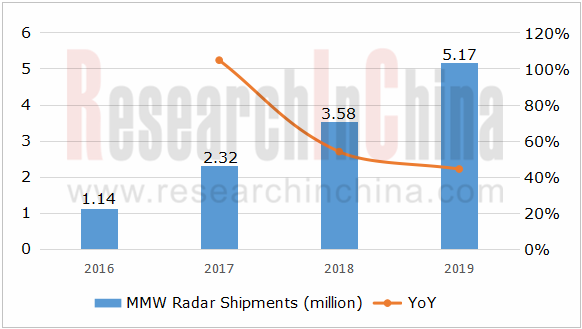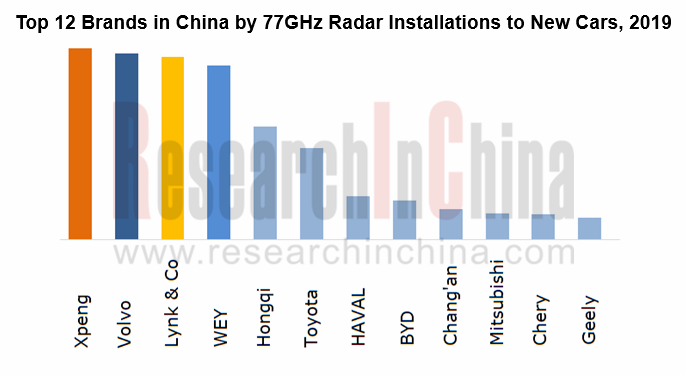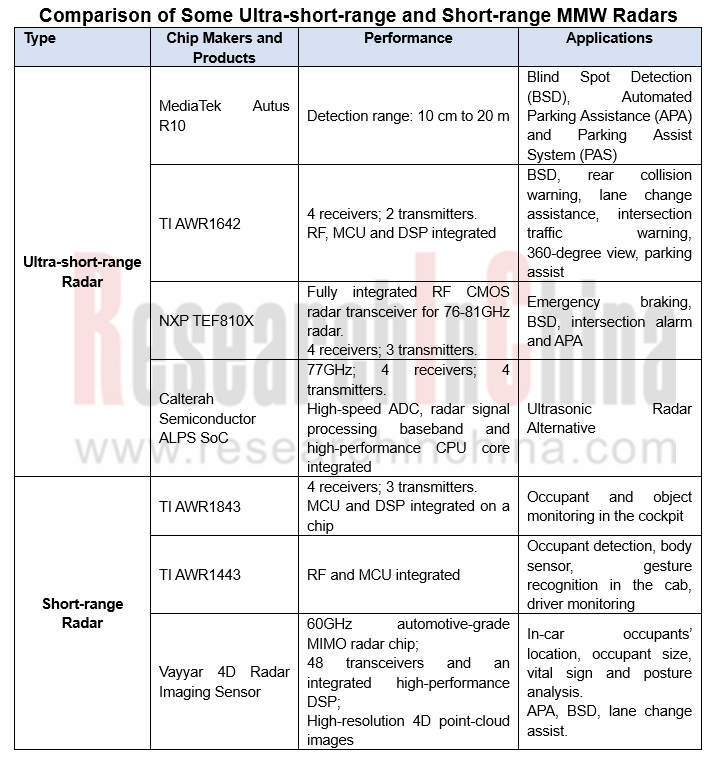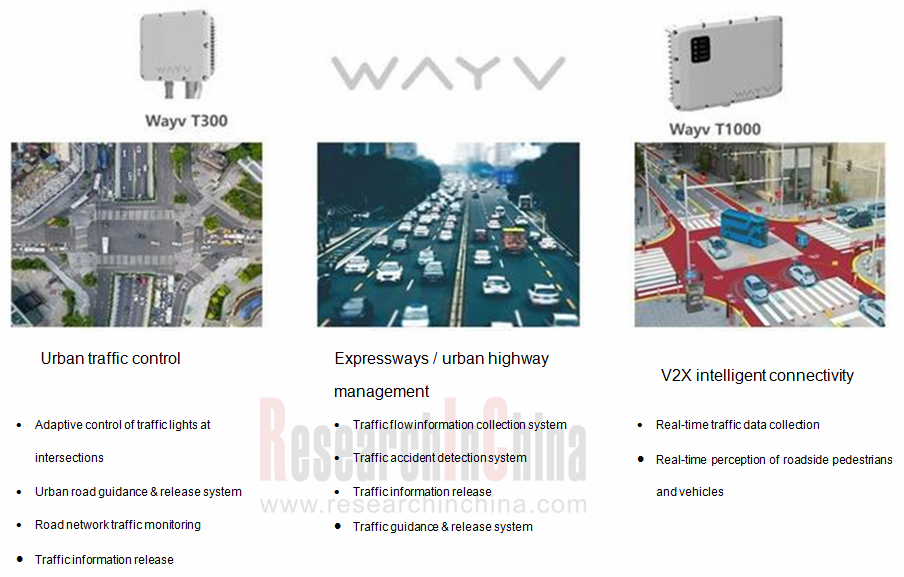Global and China Automotive Millimeter-wave (MMW) Radar Industry Report, 2019-2020
Millimeter wave radar installations soared by 44.37% year-on-year in 2019 and were available in more scenarios, encroaching on Lidar and ultrasonic.
Automotive radar wins popularity and gets increasingly installed. In 2019, 5.17 million mm-wave radars were installed in passenger cars in the Chinese market with an annualized spurt of 44.37%, particularly 77GHz radar installations with an upsurge of 69.3% from a year earlier.

Chinese carmakers have more radar installations than joint venture brands. For the newly launched models, Geely Geometry, WM Motor, BAIC ARCFOX, Chang’an, SAIC Roewe / MAXUS, FAW Hongqi, Xpeng and other homegrown brands all emphasize L2 / L2.5 / L3 autonomous driving technology and install more sensors including mm-wave radar.

Well-known radar suppliers are promoting 77GHz radar vigorously, like the latest generation of medium- and long-range 77GHz radar launched by Bosch and Continental, and at the same time famous radar chip makers are mostly rolling out the 77GHz-centric chip generally in favor of the high modulation bandwidth 2GHz and with 3 transmitters and 4 receivers to detect farther.
The upcoming RXS816xPL is a highly integrated device that addresses the needs of 77-79 GHz radar for all safety-critical applications from automatic emergency-braking (AEB) to high-resolution radar in automated driving and that performs all functions of a radar front-end in a single device – from FMCW signal conditioning to generation of digital receive data output. It resorts to high modulation bandwidth 2 GHz to realize precise distance measurement and simultaneous transmitter operation for MIMO, capable of detecting and identifying objects within 300 meters.
Texas Instruments plans to launch the 77GHz AWR2243, an integrated single-chip FMCW transceiver working in the 76- to 81-GHz band. The device has a tiny footprint and unprecedented integration and supports 5G bandwidth. Simple programming model changes enable a wide variety of sensor implementation (short, medium, long range). Additionally, the device is provided as a complete platform solution to reduce development costs.
MMW radar chip vendors have released suitable chips for more applications, especially in ultra-short range and short range.

Radar finds wider applications in scenarios like cockpit and occupant monitoring, automated parking, collaborative vehicle infrastructure system (CVIS) and intelligent transportation with the help of radar chips.
Cockpit and Occupant Monitoring
Vayyar Imaging, an Israeli provider of radar imaging sensor technology, said in November 2019 it raised $109 million in a Series D funding led by Koch Disruptive Technologies, bringing its total raised to-date to $188 million. In the automotive domain, Vayyar claims its chip enables in-cabin passenger location and classification, occupant size, vital sign and posture analysis, as well as 360° exterior mapping, including monitoring cars, objects and pedestrians around a vehicle, in all lighting and weather conditions, and in real time. At the 2018 Paris Motor Show, Valeo indeed announced it was integrating Vayyar’s radar sensors with its products to monitor infants’ breathing and trigger an alert in case of emergency. Brose and Vayyar collaborate on sensor technology for new door and interior functions. Sensors recognize occupancy in the interior at all times to ensure the necessary level of safety in the interaction of mechanical and electronic systems. These sensors will also make it possible for side doors to open and close automatically and if other vehicles or obstacles are in the way, the movement ends before the door comes into contact with any object.
For L2, L3 and L4 autonomous driving, occupant monitoring is of growing importance. Autonomous vehicle interiors are fairly flexible, like sliding seats, screens and consoles, suitable for work and relaxation. The short-range radar and visual sensors work together to identify the situation in the car in real time, and the mechanical and electronic systems interact to ensure the safety.
Automated Parking
In December 2019, ZongMu Technology released in Xiamen city the second-generation autonomous parking product -- AVP Gen.2 that has main sensors including four fisheye cameras, 12 ultrasonic sensors, and four 4D MMW radars.
When all of four surround-view cameras are blocked and only mm-wave radar is available, AVP Gen. 2 can still fully implement AVP because the radar can deliver the dense point cloud information comparable to that of Lidar and clearly outline the surrounding buildings to achieve high-precision localization based on radar point clouds.

The radar used by AVP Gen.2 is called SDR1, which gets specially optimized in the typical parking scenarios (underground / ground parking lots, parks, etc.) on the basis of traditional angle radar ADAS functions to perfectly meet all parking needs. SDR1 takes into account both of low-speed parking scenarios and high-speed ADAS, and can work under extreme conditions such as wind, heavy snow, night, etc. The product will be spawned in the fourth quarter of 2020.
CVIS and Intelligent Transportation
In April 2020, Muniu Tech rolled out three WAYV-branded radars: WAYV Air, WAYV and WAYV Pro. WAYV includes T300 and S300, which are used in intelligent transportation and intelligent security respectively. WAYV Pro breaks the detection distance limit of video and infrared sensors to reach 1,000 meters, ideal for highway accident monitoring and large-area security.
With a detection range of 300 meters, Wayv T300 covers 8 lanes, detects and tracks 128 objects simultaneously, mainly serving urban traffic data perception and planning. Wayv T1000 works at a maximum distance of 1,000 meters, suitable for long-distance and highway deployment. It can detect and track 256 objects on 10 lanes simultaneously.

Market Shares of Lidar and Ultrasonic Radar Are Squeezed
Millimeter-wave radar is developing radically, with the imaging radar as an alternative to Lidar and the ultra-short-range radar as a substitute for ultrasonic.
The thriving angle radar has lured mm-wave radar vendors to develop ultra-short-range solutions for parking, AEB and short-range blind spot detection as the alternative of traditional ultrasonic sensors.
With far better performance than ultrasonic sensors on the market, the Autus R10 chip of MediaTek offers a wider detection range. Other than distance information, it can also provide speed information while ultrasonic does not. The Autus R10 chip can be used for multiple applications including blind spot detection (BSD), parking assist system (PAS), automatic parking assistance (APA), rear automatic emergency braking, cross-traffic alerts, door opening alerts and ultra-short-range BSD.
The most cost-effective ultrasonic sensor has a slow response to object detection, and it cannot classify objects into human and non-human, while mm-wave radar can perform object classification and biometric monitoring.
Many chip vendors, including traditional radar chip giants such as NXP, TI and Infineon, have launched solutions that shore up high-resolution radar. High-resolution imaging radar will outperform Lidar in terms of cost and performance. In some cases, imaging radar may identify objects such as bicycles, pedestrians, or small obstacles on the road and it also can deal with severe weather conditions.
Lidar will be replaced by Camera + imaging MMW Radar + V2X, said by Lars Reger, CTO of the NXP Semiconductors Automotive Division. The focus of the collaboration between NXP and HawkEye Technology is to create high-resolution imaging radar.
MMW Radar Boosts the Plasticization of Automotive Exterior Parts
Radars are generally fixed behind the car logo or the grille, and integrated into the lights, roof, etc. Millimeter wave radar detects the object, distance, speed and position by emitting electromagnetic waves, which are extremely sensitive to metals, and detecting echoes. In the traditional design, car head and door panels mostly made of metal cannot hide the radar.
Radars must come with plastic peripheral parts whose electrolyte conductivity should be low, especially the materials cannot contain carbon fiber or metals with electronic shielding effect. Covestro, BASF, Lotte, Orinko, Sumitomo, Mitsubishi and the like have developed wave-transparent materials PC, PP, ABS and so on for automotive exterior parts.
OEMs and Tier 1 Suppliers' Cost Reduction and Efficiency Enhancement Strategy Analysis Report, 2025
ResearchInChina released the "OEMs and Tier 1 Suppliers' Cost Reduction and Efficiency Enhancement Strategy Analysis Report, 2025", summarizing hundreds of cost reduction strategies to provide referen...
Automotive Fixed Panoramic Sunroof and Smart Roof Research Report, 2025
With the intelligent application of car roofs as the core, this report systematically sorts out a series of new products such as fixed panoramic sunroof/openable sunroof, ceiling screen, roof ambient ...
Automotive-Grade Power Semiconductor and Module (SiC, GaN) Industry Research Report, 2025
SiC/GaN Research: Sales volume of 800V+ architecture-based vehicles will increase more than 10 times, and hybrid carbon (SiC+IGBT) power modules are rapidly being deployed in vehicles.
Sales volume o...
Cockpit Agent Engineering Research Report, 2025
Cockpit Agent Engineering Research: Breakthrough from Digital AI to Physical AI
Cockpit Agent Engineering Research Report, 2025 starts with the status quo of cockpit agents, summarizes the technical ...
Prospective Study on L3 Intelligent Driving Technology of OEMs and Tier 1 Suppliers, 2025
L3 Research: The Window of Opportunity Has Arrived - Eight Trends in L3 Layout of OEMs and Tier 1 Suppliers
Through in-depth research on 15 OEMs (including 8 Chinese and 7 foreign OEMs) and 9 Tier 1 ...
China Commercial Vehicle IoV and Intelligent Cockpit Industry Research Report 2025
Commercial Vehicle IoV and Cockpit Research: The Third Wave of Passenger Car/Commercial Vehicle Technology Integration Arrives, and T-Box Integrates e-Call and 15.6-inch for Vehicles
I. The third wav...
Intelligent Vehicle Electronic and Electrical Architecture (EEA) and Technology Supply Chain Construction Strategy Research Report, 2025
E/E Architecture Research: 24 OEMs Deploy Innovative Products from Platform Architectures to Technical Selling Points
According to statistics from ResearchInChina, 802,000 passenger cars with domain...
Research Report on Intelligent Vehicle Cross-Domain Integration Strategies and Innovative Function Scenarios, 2025
Cross-Domain Integration Strategy Research: Automakers' Competition Extends to Cross-Domain Innovative Function Scenarios such as Cockpit-Driving, Powertrain, and Chassis
Cross-domain integration of ...
China Autonomous Driving Data Closed Loop Research Report, 2025
Data Closed-Loop Research: Synthetic Data Accounts for Over 50%, Full-process Automated Toolchain Gradually Implemented
Key Points:From 2023 to 2025, the proportion of synthetic data increased from 2...
Automotive Glass and Smart Glass Research Report, 2025
Automotive Glass Report: Dimmable Glass Offers Active Mode, Penetration Rate Expected to Reach 10% by 2030
ResearchInChina releases the Automotive Glass and Smart Glass Research Report, 2025. This r...
Passenger Car Brake-by-Wire (BBW) Research Report, 2025
Brake-by-Wire: EHB to Be Installed in 12 Million Vehicles in 2025
1. EHB Have Been Installed in over 10 Million Vehicles, A Figure to Hit 12 Million in 2025.
In 2024, the brake-by-wire, Electro-Hydr...
Autonomous Driving Domain Controller and Central Computing Unit (CCU) Industry Report, 2025
Research on Autonomous Driving Domain Controllers: Monthly Penetration Rate Exceeded 30% for the First Time, and 700T+ Ultrahigh-compute Domain Controller Products Are Rapidly Installed in Vehicles
L...
China Automotive Lighting and Ambient Lighting System Research Report, 2025
Automotive Lighting System Research: In 2025H1, Autonomous Driving System (ADS) Marker Lamps Saw an 11-Fold Year-on-Year Growth and the Installation Rate of Automotive LED Lighting Approached 90...
Ecological Domain and Automotive Hardware Expansion Research Report, 2025
ResearchInChina has released the Ecological Domain and Automotive Hardware Expansion Research Report, 2025, which delves into the application of various automotive extended hardware, supplier ecologic...
Automotive Seating Innovation Technology Trend Research Report, 2025
Automotive Seating Research: With Popularization of Comfort Functions, How to Properly "Stack Functions" for Seating?
This report studies the status quo of seating technologies and functions in aspe...
Research Report on Chinese Suppliers’ Overseas Layout of Intelligent Driving, 2025
Research on Overseas Layout of Intelligent Driving: There Are Multiple Challenges in Overseas Layout, and Light-Asset Cooperation with Foreign Suppliers Emerges as the Optimal Solution at Present
20...
High-Voltage Power Supply in New Energy Vehicle (BMS, BDU, Relay, Integrated Battery Box) Research Report, 2025
The high-voltage power supply system is a core component of new energy vehicles. The battery pack serves as the central energy source, with the capacity of power battery affecting the vehicle's range,...
Automotive Radio Frequency System-on-Chip (RF SoC) and Module Research Report, 2025
Automotive RF SoC Research: The Pace of Introducing "Nerve Endings" such as UWB, NTN Satellite Communication, NearLink, and WIFI into Intelligent Vehicles Quickens
RF SoC (Radio Frequency Syst...